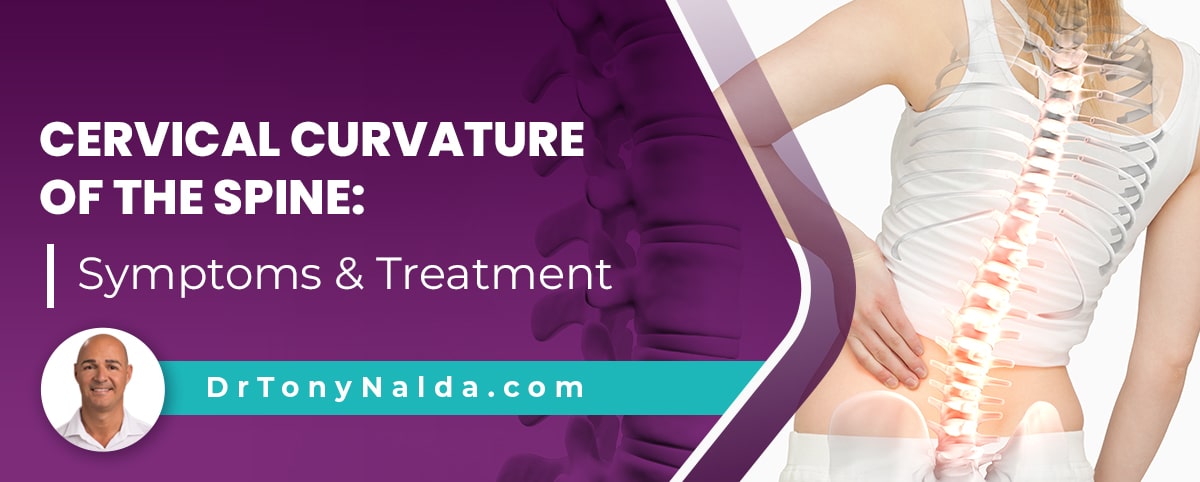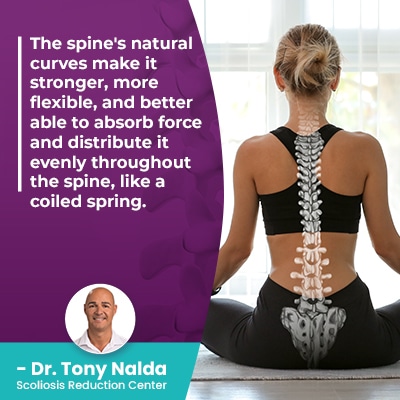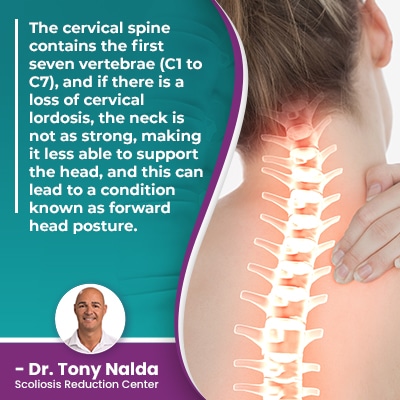Cervical Curvature Of The Spine: Symptoms & Treatment

Most people realize that the spine is naturally curved, which is what gives it a soft 'S' shape when viewed from the sides, but few realize how important those natural curves are to spinal health and function. There are three main spinal sections, each with its own curvature type, and the cervical spine refers to the neck.
The cervical spine connects the brain to the rest of the body. A natural cervical curvature bends inwards, towards the body's center, but if that curve is lost, the biomechanics of the spine are disrupted and forward head posture can become an issue.
Exploring some basic spinal anatomy is important when it comes to understanding what happens when one of the spine's healthy curves is lost.
Table of Contents
Anatomy of a Healthy Spine
A healthy spine is curved at each of its main sections, and maintaining these healthy curves is more important than most realize.
The spine's natural curves are why it appears straight when viewed from the front and/or back and give it a soft 'S' shape when viewed from either side.
The spine's main sections are the cervical spine (neck), thoracic spine (middle/upper back), and the lumbar spine (lower back).
The spine consists of vertebrae (bones) stacked on top of one another in a straight and neutral alignment, and adjacent vertebrae are separated by an intervertebral disc.
The spinal discs combine forces to facilitate flexible movement, provide the spine with structure as adjacent vertebrae attach to the disc in between, act as the spine's shock absorbers, and prevent friction from being generated during movement.
 The spine's natural curves make it stronger, more flexible, and better able to absorb force and distribute it evenly throughout the spine, like a coiled spring.
The spine's natural curves make it stronger, more flexible, and better able to absorb force and distribute it evenly throughout the spine, like a coiled spring.
While there is a natural range of curvature degrees that vary from person to person, if a spinal curve is lost, or falls beyond a normal range, problems can occur.
There are two main types of spinal curvatures: those that bend inwards, towards the body's center, and those that bend outwards, away from the body's center.
Lordosis and Kyphosis
As mentioned, each spinal section has a characteristic curvature type: lordosis vs kyphosis.
Lordosis refers to the cervical and lumbar spine's curvature type that bends inwards in a standard 'C' shape, and kyphosis refers to the thoracic spine's outward bending spinal curve that makes a reverse 'C' shape.
A natural range of cervical lordosis would fall within 20 to 40 degrees, while a natural range of lumbar lordosis falls within a range of 40 to 60 degrees, and a healthy range of thoracic kyphosis falls between 20 and 40 degrees.
So as you can see, it's natural for these curvature sizes to vary from person to person, but if one or more of these curves falls beyond a normal range, the spine's overall health, strength, and function are disrupted
So what happens if a healthy cervical curvature is lost?
The Cervical Spine
A healthy cervical curvature is lordotic, and this is important not only because the spine works in tandem with the brain to form the central nervous system (CNS), the cervical spine also connects the brain to the rest of the body, and supports the weight of the head.
 The cervical spine contains the first seven vertebrae (C1 to C7), and if there is a loss of cervical lordosis, the neck is not as strong, making it less able to support the head, and this can lead to a condition known as forward head posture.
The cervical spine contains the first seven vertebrae (C1 to C7), and if there is a loss of cervical lordosis, the neck is not as strong, making it less able to support the head, and this can lead to a condition known as forward head posture.
What's Forward Head Posture?
When there is a significant loss of cervical lordosis, the neck becomes excessively straight, and affects posture by shifting the head forward; this develops out of an effort to further stabilize the neck and counteract the cervical spine's loss of lordosis.
The head's average weight is approximately 10 pounds, but if it shifts forward as little as one inch, the weight of the head on the neck doubles, with a two-inch shift increasing the head's weight by up to 30 pounds.
Now, the postural deviation that forward head posture involves introduces a lot of uneven forces to the spine, its surroundings, and the entire body; the body attempts to twist and turn unnaturally to counteract these uneven forces and better support the head.
The health of each spinal section's curve is dependent on the others, so with a loss of cervical lordosis comes the loss of other healthy curves as the thoracic spine can become excessively straight too.
The spinal cord, containing the 31 pairs of spinal nerves, passes through the spinal canal, and if we are looking from the lumbar spine upwards, the spinal canal will traverse the normal curve of the lower spine, up through the thoracic spine, and continue into an excessively-straight cervical spine.
With an atypical cervical curvature, the distance of the canal will increase; the spinal cord can only stretch up to 10 percent so this introduces a lot of adverse mechanical tension that can irritate the spine.
So in addition to the development of forward head posture, what are some common symptoms associated with an unhealthy cervical curvature?
Symptoms of an Unhealthy Cervical Curvature
Just as there can be a wide range of curvature degrees, symptoms that accompany a loss of the spine's healthy lordosis can be equally wide-ranging.
Factors such as patient age, cause, and severity shape the type of symptoms a person is likely to experience:
- Neck pain
- Shoulder pain
- Muscle weakness
- Muscle spasms
- Headaches
- Forward head posture
In addition, as the spine and brain work together to form the body's central nervous system, spinal conditions can also impact brain-body communication.
A loss of cervical lordosis causes a straighter neck, and this also affects the meninges (protective membranes around the brain and spinal cord), and the meninges support cerebral, cranial vasculature, and work with the cerebrospinal fluid (CSF) to further protect the central nervous system.
The dura mater is a layer of the meninges that consists of durable ligaments that are naturally diagonal.
If the neck becomes excessively straight, the spinal cord within, and its meninges, are squeezed, introducing compressive forces, and this adverse mechanical tension in the neck area causes the body to twist unnaturally in an attempt to decrease the level of adverse spinal tension, and this can also lead to the development of other spinal conditions, such as scoliosis.
Treatment Options for a Loss of Cervical Lordosis
When the cervical spine's vertebrae are aligned as they should be, its natural curve is in place, but if it becomes excessively straight, cervical spine alignment is disrupted, introducing uneven forces.
A normal cervical spine is one that can bend, twist, look up and down, and easily support the weight of the head, and when it comes to restoring normal cervical lordosis, this involves proactive treatment that addresses its underlying cause.
Injury that involves ligament damage, such as whiplash, can cause a loss of cervical lordosis, but lifestyle factors are a more common cause of an abnormal curvature of the cervical spine.
What's become known as tech neck is a modern problem that involves exposing the neck to chronic poor posture and increasing pressure by constantly looking down at devices.
Remember, shifting the head forward as little as one inch, which is what happens when a person is constantly looking down at screens, increases the weight of the head on the neck, and this pressure, over time, can cause the cervical vertebrae to shift out of alignment with the rest of the spine.
Carrying excess weight means extra pressure on the joints, including the joints of the spine, and chronic poor posture introduces adverse spinal tension that, over time, can affect the spine's vertebrae and surrounding muscles and ligaments that support the spine.
Staying active is also important; the very design of the spine is based on movement, so if the neck isn't regularly stretched and moved, it can become sore, stiff, weak, and can develop an unnatural curve, and/or a loss of its natural lordosis.
In most cases, a combination of lifestyle guidance, condition-specific chiropractic care, and physical therapy can help prevent further damage, work towards realigning the vertebrae of the cervical spine, and increase strength of the spine's surrounding muscles and ligaments for optimal spinal support and stabilization.
Conclusion
Here at the Scoliosis Reduction Center, I address abnormal spinal curvatures by determining their underlying cause and shaping treatment plans around causation.
The spine's healthy curves allow it to function as it was designed, but if there is a loss of one or more of the spine's natural curves, this disrupts the biomechanics of the entire spine.
If the spine loses a healthy curve, its vertebrae are no longer aligned, and this introduces uneven forces to the body and the spine's surrounding ligaments, muscles, and nerves, and adverse spinal tension to the spine itself.
When the cervical spine loses its natural lordotic curve, it becomes excessively straight, which increases the weight of the head on the neck, and can cause a number of symptoms such as neck pain, shoulder pain, muscle weakness and pain, headaches, and forward head posture.
Proactive treatment works towards restoring a natural range of cervical lordosis through lifestyle guidance, chiropractic adjustments, and physical therapy.
Dr. Tony Nalda
DOCTOR OF CHIROPRACTIC
After receiving an undergraduate degree in psychology and his Doctorate of Chiropractic from Life University, Dr. Nalda settled in Celebration, Florida and proceeded to build one of Central Florida’s most successful chiropractic clinics.
His experience with patients suffering from scoliosis, and the confusion and frustration they faced, led him to seek a specialty in scoliosis care. In 2006 he completed his Intensive Care Certification from CLEAR Institute, a leading scoliosis educational and certification center.
About Dr. Tony Nalda
 Ready to explore scoliosis treatment? Contact Us Now
Ready to explore scoliosis treatment? Contact Us Now





